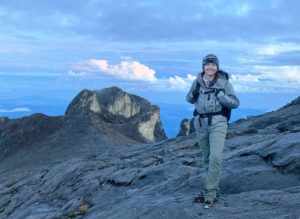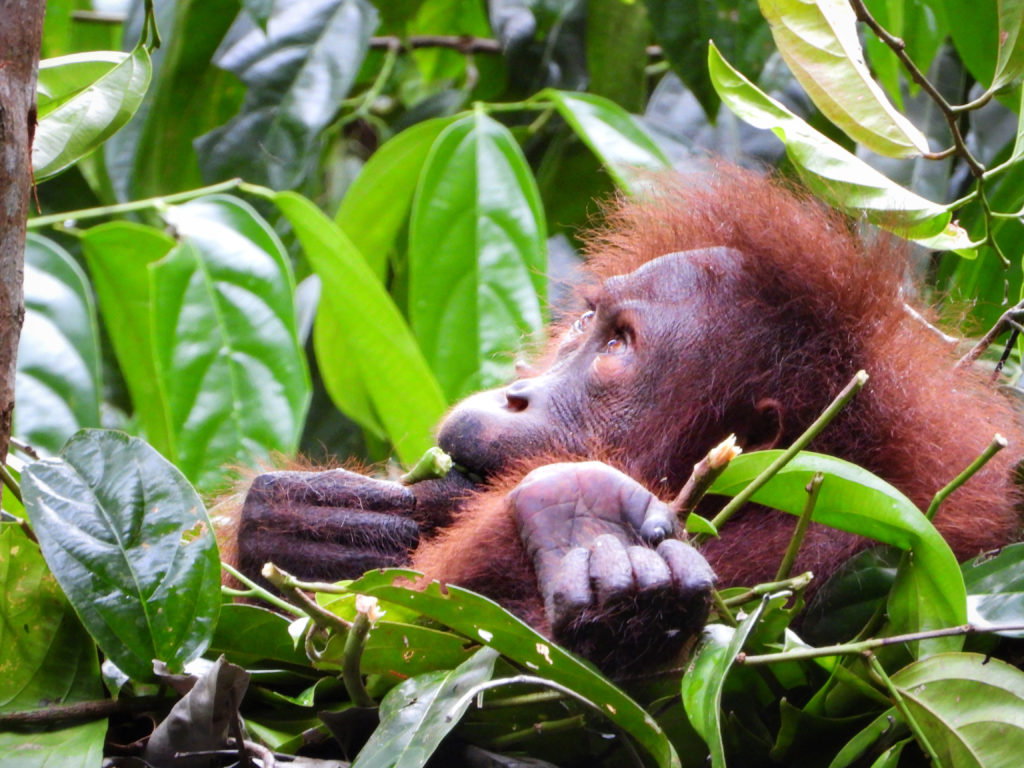by Melissa Butynski, Conservation Coordinator

As an early-career conservationist, I have been immensely privileged to experience some genuinely fantastic wildlife encounters. I’ve assisted in the relocation of Rocky Mountain big horn sheep, collared mountain lions, and almost crashed into a hippo while biking in east Africa. However, none of these compare to my remarkable experience while visiting Borneo, Malaysia, in May.
With travel restrictions lifted, I set off with other colleagues from the Center to visit partners in Malaysia before making our way to the island of Borneo for the 2nd Asia Parks Congress. After a whirlwind of travel and shaking off my dusty social skills for in-person meetings, I found myself strolling a canopy walk in the Kabili-Sepilok Forest Reserve as the sun dipped below the horizon and the rainforest reawakened as the day’s oppressive heat began to lift. My eyes anxiously searched the surrounding canopy hoping to catch a glimpse of any number of incredible bird species endemic to the region while trying to temper my hopes of encountering one of the local orangutans.
Orangutans are critically endangered apes only found on the islands of Borneo and Sumatra. Populations have been in decline for decades as a result of a litany of threats, including illegal hunting, habitat loss from land conversion for agriculture, and habitat fragmentation from development of linear infrastructure such as roads, railways, and transmission lines. A recent study predicts that without intervention, more than 26,000 orangutans (one quarter of the population) will lose their habitat by 2032.
Fortunately, during my time in Malaysia it was clear that the local conservation community is working hard to ensure such a bleak reality doesn’t come to fruition. Their efforts range from campaigns to increase awareness of the important role orangutans play in seed dispersal, to working closely with oil palm plantations to protect remaining habitat, to installing and maintaining orangutan-specific arboreal crossings over roadways and rails. Despite the good work currently being done, at the back of my mind I couldn’t quite escape the feeling that if I was going to see an orangutan in the wild, it might be now or never.
My guide informed me that in the Malay language, orang means “person,” and utan is derived from hutan, which means “forest.” Thus, orangutan means “person of the forest.”
During my walk in the forest reserve, my heart leapt when my guide waved me down; keeping his voice low and motions slow, he directed my gaze—and I directed my zoom lens—through the dense foliage to a bundle of orange fussing about. In awed silence, we watched as a female orangutan pulled branches and leaves from trees, arranging them about her as she constructed her nest for the night.
Orangutans are well known for being shy, but this female only threw us a few cursory glances while continuing to arrange branches. Silent moments continued to slide past until, to my utter delight, the female looked down at her nest, judged it complete, and plopped down to test its comfort. She rolled and stretched, reaching below her to adjust an errant twig before settling back into a relaxed pose and popping a ripe fruit from a nearby branch as a snack. [Scroll down to see the video!]
I’ve always been careful not to anthropomorphize the animals I engage with. However, at this moment, with the first great ape species I’ve encountered in the wild, I couldn’t help but marvel at how similar her actions were to me at the end of a long day, sitting in comfort with a few snacks close by.
Walking back along the canopy, my guide informed me that in the Malay language, orang means “person,” and utan is derived from hutan, which means “forest.” Thus, orangutan means “person of the forest.”
My first wild encounter with a person of the forest made me ever more grateful for the opportunity to work on the Center for Large Landscape Conservation’s A.P.E. Project to better protect great apes and gibbons from the impacts of linear infrastructure development.
Video by Melissa Butynski, CLLC



